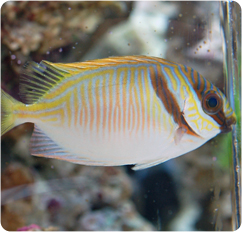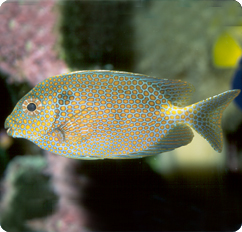|
Family Siganidae - Rabbitfishes
Outstanding, Albeit Underappreciated, Marine Algae Grazers 
There are currently six families of surgeonfishes from the Suborder Acanthuroidei. There are, of course, the surgeonfishes and tangs (Family Acanthuridae), but there are also the spadefishes from the Family Ephippidae and those spadefishes from the Family Scatophagidae (along with the butterfishes and scats). Then there are the Moorish idols (Family Zanclidae), the Luvarsus fishes, and, finally, the subject of this article, the rabbitfishes of the Family Siganidae.
There are currently 32 species of rabbitfishes in one genus, and they are all indigenous to the Indo-Pacific and eastern Mediterranean. Called rabbitfishes because of the similarity of their nose to that of their terrestrial namesake (at least to the Ancients who first used the word siganus to describe these fishes), their grazing ability rivals any mammalian bunny. All rabbitfishes are diurnal herbivores that feed on algae, and in some places, like the Great Barrier Reef, they are being looked to as a solution for algae outbreaks that are outcompeting coral.
Despite the rabbitfishes apparent suitability for the marine aquarium, they have been relatively infrequent in the marine ornamental trade in the United States. This is unfortunate, as some species are quite colorful, disease-resistant and very hardy. Aquarists have become familiar with some of the more frequent offerings such as the foxface rabbitfish (S. vulpinus), the bicolor foxface rabbitfish (S. uspi), onespot foxface rabbitfish (S. unimaculatus), the scribbled rabbitfish (S. doliatus), and the Virgate Rabbitfish (S. virgatus). In addition to these attractive aquarium species, there are some real standouts in terms of aesthetics. For example, consider the beautiful gold spotted rabbitfish (S. punctatus) and the silver foxface rabbitfish (S. magnificus).

Many of these species will readily consume problematic bryopsis algae, red turf algae, hair algae, and valonia, and most make excellent additions to peaceful community tanks. As juveniles, Rabbitfish will frequently shoal, but they do become more aggressive as adults and should therefore be kept only one to an aquarium unless that aquarium is very large.
The reef aquarist does need exercise caution when adding any rabbitfish to a reef aquarium. These fishes are known to occasionally nip soft corals and stony corals with large polyps.
In terms of diet, in addition to naturally growing algae in your aquarium, a varied diet consisting of large chunks of meaty foods (e.g. krill, raw table shrimp, squid, clam, and mussel) will be appreciated. It is also a good idea to supplement with some type of herbivore food on a regular basis.
In conclusion, rabbitfishes are underappreciated in the hobby. While they may lack some of the pizzazz of more ostentatious species, they are both hardy and interesting to observe in the home aquarium. Despite their poisonous spines (do be careful!), some rabbitfishes are without parallel for their disease resistance, algae-eating capability and beauty, and they can be an outstanding addition to a marine aquarium.
|